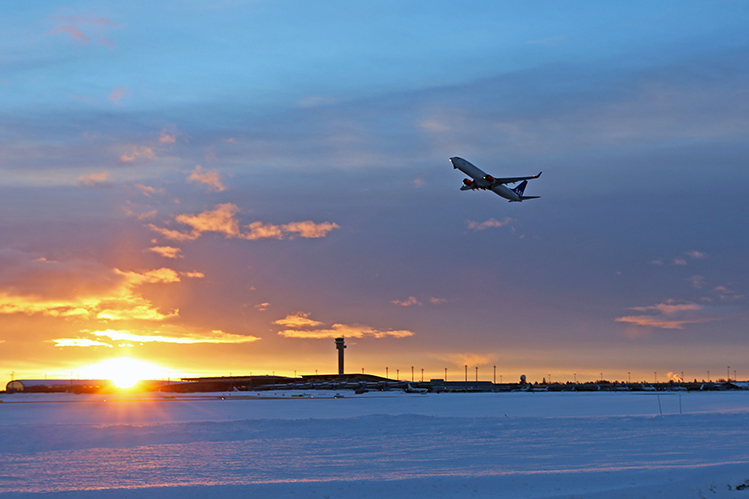The demand for fresh Norwegian seafood continued to grow in 2020 despite the COVID-19 crisis. At Avinor Oslo Airport another record was set, with more than 110,000 tons of seafood exported out of Norway. In addition, more than 120,000m3 of medical protection wear arrived by air to Oslo Airport to support the Norwegian health authorities during the COVID-19 outbreak.
“With the global air cargo industry heavily influenced by COVID-19, we are very pleased by the fact that our airline partners have prioritised online cargo capacity from Norway and Oslo Airport,” says Martin Langaas, Director of Cargo, Avinor. “Especially in a time with severe global shortage of air freight capacity. This is primarily because of a high demand for Norwegian seafood, combined with a significant increase of medical protection wear flown to Norway. In addition, we have seen a strong increase in e-commerce. The increased rate level of air cargo has contributed to more airlines using passenger aircraft as dedicated freighters, so called ‘preighters’ to and from Oslo Airport.”

The demand for fresh Norwegian seafood continued to grow in 2020 (photo: Avinor).
70 flights a week of Norwegian seafood
In total, more than 110,000 tons of seafood were flown from Oslo Airport to major markets around the world, with Japan, South Korea and the United States being the largest export markets.
“As a consequence of reduced air cargo capacity in the rest of Europe, we have seen a higher commitment to uplift from Norway from the Norwegian seafood industry,” Langaas explains. “Because of this, we have seen yet another record year for seafood export by air, despite the COVID-19 crisis. At most, we have had over 70 weekly flights carrying fresh Norwegian seafood from Oslo Airport to Asia and Africa.”
Norway in a unique position
The total volume of air cargo at the country’s main airport has decreased marginally as a result of less domestic mail flown and reduced domestic traffic, but far less than other airports in the region.
“Norway is in a unique position because we have a stable export commodity in high demand with Norwegian seafood as an air cargo commodity,” says Langaas. “This is attractive to airlines, utilising the imbalance of trade flows between Asia and Europe to fill fresh seafood on their return flights back to Asia. For example, Qatar Airways has opened another seafood route from Norway by adding another stop at Avinor Evenes Airport on its return to Doha from Europe.”
Avinor has improved air freight capacity
“There is a saying that ‘no one is in more of a rush than a dead salmon’,” Langaas explains. “For the seafood industry, time-efficient transport to Norway’s largest export markets represents a significant competitive advantage.”
This is confirmed by Trond Davidsen, Vice President, The Norwegian Seafood Federation: “For our members, Avinor’s efforts to ensure air cargo capacity from Norway in a very turbulent time for international aviation have been crucial to reaching world markets with fresh seafood. It is gratifying to note that Avinor has managed to maintain, and even improve, the air freight capacity for Norwegian transport of seafood through the COVID-19 crisis.”
Airborne infection control equipment
Since 18 March 2020, Avinor has contributed to securing essential supplies of medical infection wear from Asia to Norway.
“In a very demanding and difficult time for the country, it is good that we can utilise our air cargo community and competence,” says Langaas. “The fact that Avinor has been able to help the Norwegian health authorities and the Ministry of Health securing a steady supply of medical protection wear, on which the country’s hospitals and municipalities are completely dependent, shows the valuable role played by aviation in the Norwegian health preparedness.”
Major developments in the express market
Apart from seafood and medical protection wear, there is another industry that sees a solid increase. The second-largest freight segment in volume, the express market, constitutes a significant part of overall value of air cargo flown in and out of Norway.
This is partly because of increased international trade where particularly trade via the internet has grown substantially, a tendency that has increased with the COVID-19 crisis.
“The increase varies between different industries,” says Terje Aarbog, Managing Director, DHL Express Norway. “It is clear, however, that Norwegians in general tend to use the internet as a marketplace to buy a broad variety of goods. DHL Express Norway has maintained deliveries during the pandemic, with an increase of volume from e-commerce, but also maintained the performance of important shipments to Norwegian industries and business, hospital and health enterprises, as well as society in general.”
The total number of freight tons at Oslo Airport in 2020 was 163,000 tons, which corresponds to a decrease of 7% compared to 2019. This means that in 2020 Oslo Airport took the position of the largest freight airport in the Nordic region (measured in tons flown) and reinforced its role as the largest freighter airport (number of cargo aircraft).







